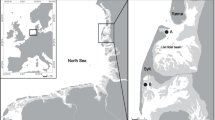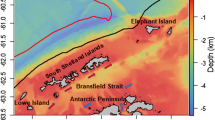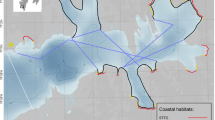Abstract
The Antarctic marine ecosystem is largely dominated by Euphausia superba, the most abundant krill species consumed by a wide array of predators, including whales, penguins, flying birds, seals, fish and cephalopods. The current management of the krill fishery follows an ecosystem-based approach which takes into account the distribution, abundance of E. superba and its main predators plus their interactions. Mackerel icefish, Champsocephalus gunnari, was once considered the most abundant meso-pelagic fish species and a very important consumer of E. superba until its population was collapsed by overfishing in the early 90s. Currently, C. gunnari populations are slowly recovering which may increase predation on E. superba. Therefore, in this study, we analyze the distribution and density of E. superba and C. gunnari, gain some insights about the type of foraging strategy of C. gunnari and estimate its consumption of E. superba under three different biomass scenarios of C. gunnari: 7000 (Bt), 70,000 (B50%) and 140,000 (B0) t. We focus particularly on the potential area of overlap between C. gunnari and Adélie penguin (Pygoscelis adeliae) off the South Orkney islands. Bayesian geostatistical models were employed to test whether C. gunnari followed an ideal or generalized ideal-free distribution. Spatially explicit consumption estimates were derived under the scenarios of 7000 (Bt), 70,000 (B50%) and 140,000 (B0) t of C. gunnari biomass. We found that both species exhibit a higher probability of presence and density north of the South Orkney Islands, where they present a high overlap. The probability of presence of Champsocephalus gunnari was best explained by the ideal-free distribution whereas its acoustic density was best explained by an independent spatial model, showing no relation to the distribution of E. superba. Individual consumption of E. supeba by C. gunnari was estimated to be 153.5 ± 77.9 g ind−1. Thus, current biomass (Bt) would only remove ~ 0.07% of E. superba biomass in the focus area. Under a pre-exploitation biomass level (B0), C. gunnari would remove ~ 1.4% of E. superba biomass. This study provides novel insights into the relationship between a key species like E. superba and a highly specialized consumer such as C. gunnari around the South Orkney Islands and contributes to fill in an important gap regarding fish consumption of krill in the Antarctic ecosystem.





Similar content being viewed by others
Data availability
No datasets were generated or analysed during the current study.
References
Alegría N, Arana PM, Sepúlveda A (2017) Hydroacoustic survey around Elephant Island (Sub-area 48.1) and South Orkney Islands (Subarea 48.2), austral summer 2016. 2017 IEEE. In: OES Acoustics in Underwater Geosciences Symposium (RIO Acoustics), pp 1–5
Arana PM, Jones CD, Alegría NA et al (2020) Antarctic demersal finfish around the Elephant and the South Orkney islands: distribution, abundance and biological characteristics. Lat Am J Aquat Res 48:304–322
Banerjee S, Carlin BP, Gelfand AE (2014) Hierarchical modeling and analysis for spatial data. CRC Press, Boca Raton
Barange M (1994) Acoustic identification, classification and structure of biological patchiness on the edge of the Agulhas Bank and its relation to frontal features. S Afr J Mar Sci 14:333–347
Beverton RJH, Holt SJ (1957) On the dynamics of exploited fish populations. Springer, London
Brett JR (1979) Environmental factors and growth. In: Hoar WS, Randall DJ, Brett JR (eds) Fish physiology. Academic Press, New York, pp 599–675
Canseco JA, Chavez L, Niklitschek EJ et al (2023) Variability and uncertainty associated to methods for estimating diet composition: the case of Champsocephalus gunnari in the South Orkney Islands. Estuar Coast Shelf Sci 285:108302. https://doi.org/10.1016/j.ecss.2023.108302
Carlin BP, Louis TA (2008) Bayesian methods for data analysis. CRC Press, Boca Raton
CCAMLR (2009) Conservation Measure 91-03. Protection of the South Orkney Islands Southern Shelf. Schedule of conservation measures in force 2017/18. CCAMLR. Hobart, Australia
CCAMLR (2023) Scheduled conservation measures in force 2023/2024. Conservation Measures 42-01 and 42-02. CCAMLR, Hobart
CCAMLR-XXXV (2016) Conservation measure 51–07 for Krill fishery in Area 48.2. CCAMLR, Hobart
Collins MA, Shreeve RS, Fielding S, Thurston MH (2008) Distribution, growth, diet and foraging behaviour of the yellow-fin notothen Patagonotothen guntheri (Norman) on the Shag Rocks shelf (Southern Ocean). J Fish Biol 72:271–286. https://doi.org/10.1111/j.1095-8649.2007.01711.x
Cox MJ (2017) Describing krill: swarms or integration intervals? CCAMLR SG-ASAM- 17/02, Peoples Republic of China
Cressie N, Huang H-C (1999) Classes of nonseparable, spatio-temporal stationary covariance functions. J Am Stat Assoc 94:1330–1339
Croxall JP (1987) Seabirds: Feeding ecology and role in marine ecosystems. Cambridge University Press, Cambridge
Croxall JP, Reid K, Prince PA (1999) Diet, provisioning and productivity responses of marine predators to differences in availability of Antarctic krill. Mar Ecol Prog Ser 177:115–131
De la Mare WK, Williams R, Constable AJ (1998) An assessment of the mackerel icefish (Champsocephalus gunnari) off Heard Island. CCAMLR Sci 5:79–101
Dias MP, Carneiro APB, Warwick-Evans V et al (2018) Identification of marine Important bird and biodiversity areas for penguins around the South Shetland Islands and South Orkney Islands. Ecol Evol 8:10520–10529. https://doi.org/10.1002/ece3.4519
Diggle P, Ribeiro PJ (2007) Model-based geostatistics. Springer, New York
Duhamel G, Hureau JC (1985) The role of zooplankton in the diets of certain sub-Antarctic marine fish. In: Antarctic nutrient cycles and food webs. Springer, Berlin, pp 421–429
Fallon NG, Collins MA, Marshall CT, Fernandes PG (2016a) Assessing consistency of fish survey data: uncertainties in the estimation of mackerel icefish (Champsocephalus gunnari) abundance at South Georgia. Polar Biol 39:593–603
Fallon NG, Fielding S, Fernandes PG (2016b) Classification of Southern Ocean krill and icefish echoes using random forests. ICES J Mar Sci 73:1998–2008
Fielding S, Cossio A, Cox M et al (2010) A condensed history and document of the method used by CCAMLR to estimate krill biomass (B0) in 2010. Working Paper WG-EMM-16/38 submitted to the Working Group on Ecosystem Monitoring and Management, CCAMLR, Hobart. https://meetings.ccamlr.org/en/wg-emm-16/38
Flores H, Kock K-H, Wilhelms S, Jones CD (2004) Diet of two icefish species from the South Shetland Islands and Elephant Island, Champsocephalus gunnari and Chaenocephalus aceratus. Polar Biol 27:119–129. https://doi.org/10.1007/s00300-003-0570-4
Forcada J, Trathan PN, Boveng PL et al (2012) Responses of Antarctic pack-ice seals to environmental change and increasing krill fishing. Biol Conserv 149:40–50. https://doi.org/10.1016/j.biocon.2012.02.002
Fretwell SD, Lucas HL (1969) On territorial behavior and other factors influencing habitat distribution in birds. Acta Biotheor 19:16–36
Frolkina ZA (2002) Distribution of mackerel icefish (Champsocephalus gunnari)(Channichthyidae) around South Georgia at various stages of its life cycle. CCAMLR Sci 9:49–69
Frolkina ZA, Dorovskikh RS (1989) On assessment of Bertalanffy growth equation parameters and instantaneous natural mortality rate of South Georgia mackerel icefish. In: Selected scientific papers. CCAMLR, Hobart, pp 29–36
Harrison L-MK, Cox MJ, Skaret G, Harcourt R (2015) The R package EchoviewR for automated processing of active acoustic data using Echoview. Front Mar Sci. https://doi.org/10.3389/fmars.2015.00015
Hill SL, Murphy EJ, Reid K et al (2006) Modelling Southern Ocean ecosystems: krill, the food-web, and the impacts of harvesting. Biol Rev 81:581–608. https://doi.org/10.1017/S1464793106007123
Hill SL, Reid K, Thorpe SE et al (2007) A compilation of parameters for ecosystem dynamics models of the Scotia Sea-Antarctic Peninsula region. CCAMLR Sci 14:1–25
Hop H, Tonn WM (1998) Gastric evacuation rates and daily rations of Arctic cod (Boreogadus saida) at low temperatures. Polar Biol 19:293–301
Hughes NF, Grand TC (2000) Physiological ecology meets the ideal-free distribution: predicting the distribution of size-structured fish populations across temperature fradients. Environ Biol Fishes 59:285–298. https://doi.org/10.1023/A:1007608720672
Kitchell JF, Stewart DJ, Weininger D (1977) Applications of a bioenergetics model to yellow perch (Perca flavescens) and walleye (Stizostedion vitreum vitreum). J Fish Res Board Can 34:1922–1935
Kock K-H (2005) Antarctic icefishes (Channichthyidae): a unique family of fishes. A review. Part I. Polar Biol 28:862–895. https://doi.org/10.1007/s00300-005-0019-z
Kock K-H (1985) Krill consumption by Antarctic Notothenioid fish. In: Antarctic nutrient cycles and food webs. Springer, Berlin, pp 437–444
Kock K-H (1992) Antarctic fish and fisheries. Cambridge University Press, Cambridge
Kock K-H, Everson I (1997) Biology and ecology of mackerel icefish, Champsocephalus gunnari: an Antarctic fish lacking hemoglobin. Comp Biochem Physiol A Physiol 118:1067–1077. https://doi.org/10.1016/S0300-9629(97)86795-3
Kock K-H, Everson I (2003) Shedding new light on the life cycle of mackerel icefish in the Southern Ocean. J Fish Biol 63:1–21. https://doi.org/10.1046/j.1095-8649.2003.00150.x
Kock K-H, Barrera-Oro E, Belchier M et al (2012) The role of fish as predators of krill (Euphausia superba) and other pelagic resources in the Southern Ocean. CCAMLR Sci 19:115–169
Krebs JR (1979) Foraging strategies and their social significance. In: Social behavior and communication. Springer, Boston, pp 225–270
Lindgren F, Rue H (2015) Bayesian spatial modelling with R-INLA. J Stat Softw 63:1–25
Lindgren F, Rue H, Lindström J (2011) An explicit link between Gaussian fields and Gaussian Markov random fields: the stochastic partial differential equation approach. J R Stat Soc Ser B (Stat Methodol) 73:423–498. https://doi.org/10.1111/j.1467-9868.2011.00777.x
Lishman GS (2009) The food and feeding ecology of Adélie penguins (Pygoscelis adeliae) and Chinstrap penguins (P. antarctica) at Signy Island, South Orkney Islands. J Zool 205:245–263. https://doi.org/10.1111/j.1469-7998.1985.tb03532.x
Lyver PO, Barron M, Barton KJ et al (2014) Trends in the breeding population of Adélie penguins in the Ross Sea, 1981–2012: a coincidence of climate and resource extraction effects. PLoS ONE 9:e91188
MacCall AD (1986) Virtual population analysis (VPA) equations for nonhomogeneous populations, and a family of approximations including improvements on Pope’s cohort analysis. Can J Fish Aquat Sci 43:2406–2409
MacLennan DN, Simmonds EJ (1995) Fisheries acoustics, 1st edn. Chapman & Hall, London
Main CE, Collins MA, Mitchell R, Belchier M (2009) Identifying patterns in the diet of mackerel icefish (Champsocephalus gunnari) at South Georgia using bootstrapped confidence intervals of a dietary index. Polar Biol 32:569–581. https://doi.org/10.1007/s00300-008-0552-7
Majkowski J, Hearn WS (1984) Comparison of three methods for estimating the food intake of a fish. Can J Fish Aquat Sci 41:212–215
Mesa ML, Catalano B, Koubbi P, Jones CD (2013) Early ontogeny of the mackerel icefish, Champsocephalus gunnari, in the southern Scotia Arc. Polar Biol 36:797–805. https://doi.org/10.1007/s00300-013-1304-x
Miller JA (1993) Juvenile chinook (Oncorhynchus tshawytscha) and coho (O. kisutch) rearing in natural and created estuarine sloughs: foraging and daily growth. M. S. Thesis, University of Washington, Seattle, Washington
Miller DGM (2002) Antarctic krill and ecosystem management—from Seattle to Siena. CCAMLR Sci 9:175–212
Nicol S, Foster J (2016) The fishery for Antarctic krill: its current status and management regime. In: Biology and ecology of Antarctic krill. Springer, Cham, pp 387–421
North AW (2005) Mackerel icefish size and age differences and long-term change at South Georgia and Shag Rocks. J Fish Biol 67:1666–1685. https://doi.org/10.1111/j.1095-8649.2005.00874.x
Palomares MLD, Pauly D (1998) Predicting food consumption of fish populations as functions of mortality, food type, morphometrics, temperature and salinity. Mar Freshw Res 49:447–453
Parkes G (1992) NOTES ON THE USE OF VIRTUAL POPULATION ANALYSIS FOR STOCK ASSESSMENT OF THE MACKEREL ICEFISH, CHAMPSOCEPHALUS GUNNARI. Communications Scientifiques Selectionnées 49***
Parker GA, Sutherland WJ (1986) Ideal free distributions when individuals differ in competitive ability: phenotype-limited ideal free models. Anim Behav 34:1222–1242. https://doi.org/10.1016/S0003-3472(86)80182-8
Radtke RL (1990) Age determination of the Antarctic fishes Champsocephalus gunnari and Notothenia rossii marmorata from South Georgia. Polar Biol 10:321–327
Reid K, Watkins JL, Murphy EJ et al (2010) Krill population dynamics at South Georgia: implications for ecosystem-based fisheries management. Mar Ecol Prog Ser 399:243–252. https://doi.org/10.3354/meps08356
Roa-Ureta R, Niklitschek E (2007) Biomass estimation from surveys with likelihood-based geostatistics. ICES J Mar Sci 64:1723–1734
Robertis A, Higginbottom I (2007) A post-processing technique to estimate signal-to-noise ratio and remove echosounder background noise. ICES J Mar Sci. https://doi.org/10.1093/icesjms/fsm112
Rowan DJ, Rasmussen JB (1996) Measuring the bioenergetic cost of fish activity in situ using a globally dispersed radiotracer (137Cs). Can J Fish Aquat Sci 53:734–745
Rue H, Held L (2005) Gaussian Markov random fields: theory and applications. CRC Press, Boca Raton
SG-ASAM (2017) Report of the meeting of the subgroup on acoustic survey and analysis methods (SG-ASAM-17)
Shepherd TD, Litvak MK (2004) Density-dependent habitat selection and the ideal free distribution in marine fish spatial dynamics: considerations and cautions. Fish Fish 5:141–152
Sirovnik J, Voelkl B, Keeling LJ et al (2021) Breakdown of the ideal free distribution under conditions of severe and low competition. Behav Ecol Sociobiol 75:31. https://doi.org/10.1007/s00265-020-02949-3
Skaret G, Krafft BA, Calise L et al (2015) Evaluation of Antarctic krill biomass and distribution off the South Orkney Islands 2011–2015. SC-CAMLR-WG-EMM 15(54):1–2
Skaret G, Macaulay GJ, Pedersen R et al (2023) Distribution and biomass estimation of Antarctic krill (Euphausia superba) off the South Orkney Islands during 2011–2020. ICES J Mar Sci 80:1472–1486. https://doi.org/10.1093/icesjms/fsad076
Temming A, Herrmann JP (2009) A generic model to estimate food consumption: linking von Bertalanffy’s growth model with Beverton and Holt’s and Ivlev’s concepts of net conversion efficiency. Can J Fish Aquat Sci 66:683–700. https://doi.org/10.1139/F09-028
Traczyk R, Meyer-Rochow VB, Hughes RM (2020) Icefish adaptations to climate change on the South Georgia Island shelf (Sub-Antarctic). Ocean Sci J 55:303–319. https://doi.org/10.1007/s12601-020-0016-8
Trathan PN, Hill SL (2016) The importance of krill predation in the southern Ocean. In: Biology and ecology of Antarctic krill. Springer, Cham, pp 321–350
Trathan PN, Warwick-Evans V, Young EF et al (2022) The ecosystem approach to management of the Antarctic krill fishery—the ‘devils are in the detail’ at small spatial and temporal scales. J Mar Syst 225:103598. https://doi.org/10.1016/j.jmarsys.2021.103598
Trivelpiece WZ, Trivelpiece SG, Volkman NJ (1987) Ecological segregation of Adelie, Gentoo, and Chinstrap Penguins at King George Island, Antarctica. Ecology 68:351–361. https://doi.org/10.2307/1939266
Wang X, Zhang J, Zhao X (2016) A post-processing method to remove interference noise from acoustic data collected from Antarctic krill fishing vessels. CCAMLR Sci 23:17
Warwick-Evans V, Kelly N, Dalla Rosa L et al (2022) Using seabird and whale distribution models to estimate spatial consumption of krill to inform fishery management. Ecosphere 13:e4083. https://doi.org/10.1002/ecs2.4083
Watanabe S, Opper M (2010) Asymptotic equivalence of Bayes cross validation and widely applicable information criterion in singular learning theory. J Mach Learn Res 11:3571–3594
Wiff R, Roa-Ureta RH, Borchers DL et al (2015) Estimating consumption to biomass ratio in non-stationary harvested fish Populations. PLoS ONE 10:e0141538. https://doi.org/10.1371/journal.pone.0141538
Williamson CE (1993) Linking predation risk models with behavioral mechanisms: identifying population bottlenecks. Ecology 74:320. https://doi.org/10.2307/1939295
Zhu J, Zhu G (2022) Trophic linkage between mackerel icefish (Champsocephalus gunnari) and Antarctic krill (Euphausia superba) at South Georgia. Fish Res 253:106366. https://doi.org/10.1016/j.fishres.2022.106366
Acknowledgements
The Institute of Marine Research (IMR) made available all acoustic data used in the current work. J. Canseco was supported by a doctoral fellowship from Universidad de Los Lagos (Chile).
Funding
Data gathering and analysis was supported by the Chilean Antarctic Institute (INACH) and Universidad de Los Lagos research grants RT 68-18 and R29-18, respectively.
Author information
Authors and Affiliations
Contributions
J.C. and E.N. wrote the main manuscript text. J.C. post-processed E. superba acoustic data and N.A. post-processed C. gunnari acoustic data. J.C. and E.N. performed all the statistical analysis. All authors reviewed the manuscript.
Corresponding author
Ethics declarations
Competing interests
The authors declare no competing interests.
Additional information
Publisher's Note
Springer Nature remains neutral with regard to jurisdictional claims in published maps and institutional affiliations.
Rights and permissions
Springer Nature or its licensor (e.g. a society or other partner) holds exclusive rights to this article under a publishing agreement with the author(s) or other rightsholder(s); author self-archiving of the accepted manuscript version of this article is solely governed by the terms of such publishing agreement and applicable law.
About this article
Cite this article
Canseco, J.A., Alegría, N. & Niklitschek, E.J. Consumption of Antarctic krill Euphausia superba by mackerel icefish, Champsocephalus gunnari off the South Orkney Islands: filling an information gap in the current ecosystem-based management approach. Polar Biol (2024). https://doi.org/10.1007/s00300-024-03270-9
Received:
Revised:
Accepted:
Published:
DOI: https://doi.org/10.1007/s00300-024-03270-9




